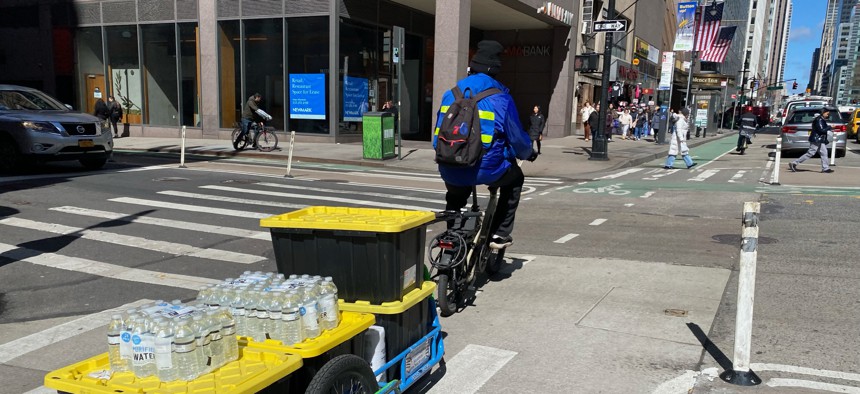Opinion
Opinion: Here’s how we can end the chaos at our curbs
Albany must give New York City home rule to pursue automated enforcement

An e-bike delivery person crosses a Midtown Manhattan intersection. (Photo by: Lindsey Nicholson/UCG/Universal Images Group via Getty Images)
New York City is just naturally chaotic – that’s the narrative. Delivery trucks double park while a car idles in the loading zone; bus lanes are clogged with cars; crosswalks are blocked, forcing pedestrians into traffic. Most of us encounter this a million times a day and accept it as inevitable. It’s not. Much of it is due to poor management of our in-demand curbs. Many cities are turning to technology to address the issue, but in typically New York City fashion, we cannot. The city is required to get authorization from Albany to use camera enforcement because we don’t have “home rule” to use technology. And without it, we can’t make real progress toward fixing the chaos at our curbs.
Camera-based enforcement automatically detects when vehicles are somewhere they shouldn’t be. It’s not an immediate “gotcha” – tickets are only triggered after a significant amount of time. Unlike human enforcement, cameras are impartial and operate 24 hours a day. They penalize drivers for dangerous misbehavior, yes, but more importantly, their consistency creates change. We’ve seen the results with speed cameras – violations have decreased over 70% since speed cameras were installed in 2014. Once drivers realize dangerous habits will be penalized, the dangerous behavior stops.
By contrast, New York is mostly managing our curbs with signage, meters, paint, and human enforcement. Just like nearly 100 years ago. But paint and signs are easy to ignore, and there are never enough traffic agents to go around. Drivers know they’ll likely get away with breaking the law by parking in a bike lane or loading zone, so they keep doing it. And it isn’t a victimless crime – it contributes to that feeling of chaos, puts cyclists and pedestrians in danger, and slows down our public transit. We can and must fix this.
Our camera-based future did get a boost in the new state budget: a program that piloted camera enforcement on some city bus lanes is now permanent, and will begin ticketing for double parking and parking at bus stops. This will go a long way toward speeding up our buses (the slowest in the nation!). But of course, only a small fraction of bus routes have a dedicated lane, and many streets don’t have a bus route at all. So while this program is a great start, more commitment is sorely needed.
Bike lanes, too, are often blocked by illegal parking; even protected lanes can become parking lots, amounting to much more than an inconvenience. A blocked bike lane can be deadly when it forces a cyclist to weave out of the lane and directly into traffic. While better design - such as hardened barriers - could keep cars out of bike lanes, not every route can or will get that treatment. Ideally, we shouldn’t have to physically stop drivers from putting someone in harm’s way. But until drivers face consequences for turning bike lanes into personal parking spots, their behavior won’t change. A current bill in the State Senate, S1398A, would create a pilot program using cameras to enforce these dangerous violations. This bill didn’t pass in 2023 but will have another chance in 2024.
Even online shopping worsens the issue. New York has set aside some curb space for loading zones, but we need vastly more for the increasing demand. And even the ones we have are often blocked; they’re rarely enforced, so many drivers see no harm in parking or standing there. When a deliverer finds a car in the loading zone, they’re left circling the block searching for another opening at the curb. Oftentimes they end up double parking, creating more congestion and chaos (disrupting everyone, including drivers). Automated enforcement is the only way to address this issue at scale and enforce loading zones so they can work as intended.
Again, the hitch: Albany must give us home rule to pursue automated enforcement at the curb. We can’t keep going to state lawmakers for permission to use every new technology. New York City must be permitted to take control of our own curbs with full home rule.
The next steps are logistically simple, but we can assume politics will slow us down. The Adams administration, and the DOT, must advocate for home rule at the curb. The City Council must pass a home rule resolution. The state legislature must pass the bike lane pilot bill and an even broader home rule bill. And the Governor must sign these bills. It’s time New York City’s curb management and enforcement enters the 21st century.
Sara Lind is co-executive director at Open Plans, where she develops and implements a legislative and policy agenda including public space management, block-level democracy and streamlining the public space permitting process to make the streets and city more livable.
NEXT STORY: Opinion: The NYPD’s stop-and-frisk practices are still here but under a new name